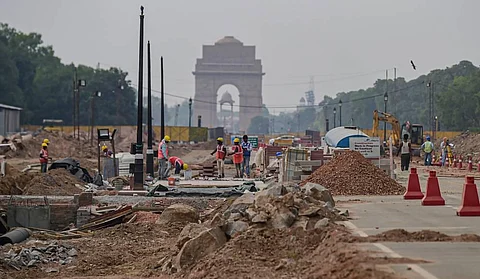

With early evidence of the second wave appearing to recede, there has been a controversy surrounding the Central Vista project. The controversy pertains to the optics of it being insensitive as many have lost their lives while others, their livelihoods. However, the very nature of the project is going to tackle the latter problems as it will directly lead to the creation of employment opportunities.
It is therefore important to evaluate the Central Vista project as a fiscal intervention. The Indian Parliament and administrative buildings do need a major face-lift. The need for a Parliament becomes important as India will add to the number of members of parliaments post the delimitation exercise -and our present Parliament can barely accommodate the existing full strength of our parliamentarians.
Therefore, there is no denying the need for building a new Parliament, along with new administrative buildings. The question is thus of timing, as many believe this is not the best possible circumstance to undertake a project of this nature.
Pandemic induced financial crises are fundamentally different from a conventional economic crisis as the present one is an outcome of a supply shock that could potentially result in a larger demand shock. What we know from our experience over the last year and a half is that the resultant demand shock is indeed larger than the initial supply shock - even though the demand shock tends to be spread over time. Thus, governments can contain the demand shock by providing financial resources in the form of economic stimulus.
This is why most governments across the world have focused on dealing with the economic fallout, including ramping up public spending after controlling the public health emergency. This is true for emerging markets and advanced economies - with advanced economies spending far more significantly as compared to emerging markets.
As an example of a resultant demand shock, many of us have already experienced nominal wage cuts, job cuts, or a combination of both. Thus, with reduced purchasing power, our ability to spend is also bound to get affected.
Therefore, the question is on how to restore the ability of the private sector, particularly the households, to spend as they did before the pandemic. The objective is to revive economic growth in a sustainable manner so that we can overcome the economic shock. It is also important for us to recognise that a substantial part of the population has gone back into poverty, thereby undoing the progress we made over the last several years. This has been an outcome of lockdowns that had halted construction activity in urban areas, which caused severe reverse migration. This is also visible when one looks at the MGNREGA data, as many were depending on it to obtain some form of income.
Given that the private sector is constrained by its ability to spend, the only way to restore economic growth in an accelerated manner is by the government extensively spending over the next few years so that India’s aggregate demand is restored. So the correct way to view the Central Vista project is as an increase in government spending - but this is necessary expenditure. That is, even in the absence of the pandemic, we would have invariably had to bite the bullet and spend on building a new Parliament. The total project would cost close to Rs 20,000 crore and this expenditure is spread across six years. In the larger scheme of things, this is too small to be even subjected to a controversy.
The expenditure over the next six years on this project will help several industries, such as cement, steel, furniture and other related sectors. Thus, the project will not just increase construction jobs but will also support several other work positions across industries. These would invariably be lost if the government were to shut the project, which would have catastrophic implications on the marginal labourers who would be employed for this project. Needless to say, construction jobs typically go to the low skilled workers and they were the most adversely hit during the pandemic. Migrant workers form a major chunk of this segment.
Even the former finance minister, P Chidambaram, agrees that the government needs to spend. However, the disagreement, or rather the debate, is on the form of spending, with one side arguing for cash transfers while the other arguing for developing infrastructure. In reality, both are needed and we should be discussing the possible alternative combinations of the two rather than viewing them as opposites.
Moreover, we should stop viewing public finance as a zero-sum game. That is, people asking for the amount for Central Vista to be spent elsewhere must recognize that doing so will adversely impact thousands of migrant workers. If there is a need to direct some financial resources elsewhere, then a logical case needs to be made for it rather than advocating shelving of projects to finance revenue expenditure.
(The writer is a New Delhi-based economist and can be reached at karanbhasin95@gmail.com)